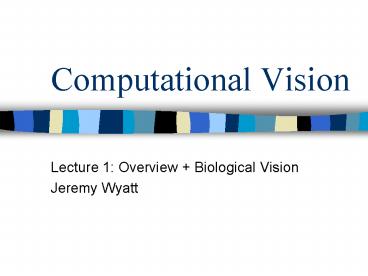Computational Vision - PowerPoint PPT Presentation
1 / 23
Title:
Computational Vision
Description:
Computational Vision Lecture 1: Overview + Biological Vision Jeremy Wyatt What you should be able to do Make informed choices about which sort of algorithms to apply ... – PowerPoint PPT presentation
Number of Views:123
Avg rating:3.0/5.0
Title: Computational Vision
1
Computational Vision
- Lecture 1 Overview Biological Vision
- Jeremy Wyatt
2
What you should be able to do
- Make informed choices about which sort of
algorithms to apply to solve specific problems. - Use standard vision libraries or software to
construct working vision systems. - Apply algorithms to simplified problems by hand.
- Discuss the advantages and drawbacks of different
methods, explaining their working.
3
Schedule
- 1 lecture a week, Mondays _at_ 2pm, Muirhead
- 1 lab/lecture a week, Thursdays _at_ 12pm (Robot Lab
or Chem Eng) - I am currently away on Monday Oct 3 and Monday
Nov 14, so there will be no lectures on those
days
4
Syllabus
- Lectures
- Biological Vision
- Edge detection
- Hough transforms
- Motion/Depth
- Recognising objects
- Recognising events
- Recognising faces
- Visual attention
- Labs
- Matlab tutorials
- Edge detection
- Hough transforms
- Face recognition
- Object recognition
5
Assessment
- 70 1.5 hour unseen exam in May/June
- 30 3 page experimental write-up of one of
your labs (in pairs) - (due Dec 7 12 noon)
6
Biological Vision
- Light and image formation
- Retinal Processing
- Colour
- Visual Pathway
- Striate Cortex
7
Visible spectrum
- Humans perceive electromagnetic radiation with
wavelengths 380-760nm (1 nm 10-9 m)
0.1nm 10nm
1000nm
8
Image Formation
- f is the focal length (in metres)
- is the power of the lens (in dioptres)
- Human eye has power 59 dioptres
Image plane
Lens
Light rays
f
9
Image Formation
- Most of the refractive power of the human eye
comes from the air-cornea boundary(49 of 59
dioptres) - As an object moves closer the power of the lens
must increase to accommodate - So if the object is infinitely far away
- But if it is 1m away the lens must
- change shape to produce a sharp image
u
v
10
Image Formation
- As an object moves in world how does it move
across the image plane? - If the image plane is curved then as q gets
larger this becomes a worse and worse
approximation
h
v
q
i
u
11
Retinal Processing
- 120m rods, 6m cones
12
Retinal Processing
- Amacrine and horizontal cells integrate receptor
outputs - More rods connect to each ganglion cells less
acuity, but greater sensitivity - Ganglions have receptive fields
13
Types of Ganglion cell
- Centre surround cells
OFF Cell
ON Cell
Light
OFF area
ON area
ON area
OFF area
Time
Light spot
14
Perceptual effects
15
Colour
- Two theories/systems
- Trichromatic (Young-Helmholtz)
- Explains
- How we discriminate wavelengths 2nm in difference
- How we can match a mixture of wavelengths to a
single colour - Some types of colour blindness
16
Colour
- Trichromatic theory cant explain colour blending
Bluey green
Orange
?
Greeny red?
?
Yellowy blue?
17
Opponent Colour Theory
- Ganglion ON cells sensitive to outputs of cones
OFF
ON
18
Opponent colour theory
Red on
Green off
Yellow on
Excitatory
Inhibitory
19
After images
20
Visual pathway
21
The striate cortex
- Composed of hyper-columns
- Within each are columns of cells tuned to
features of a particular orientation
22
Summary
- Image formation
- Very early visual processing
- Filling in and perceptual effects
- Colour perception
- Eye-cortex mapping
23
Reading
- Vicki Bruce, Visual Perception, pp1-60
- Neil Carlson, Physiology of Behavior, pp142-157































